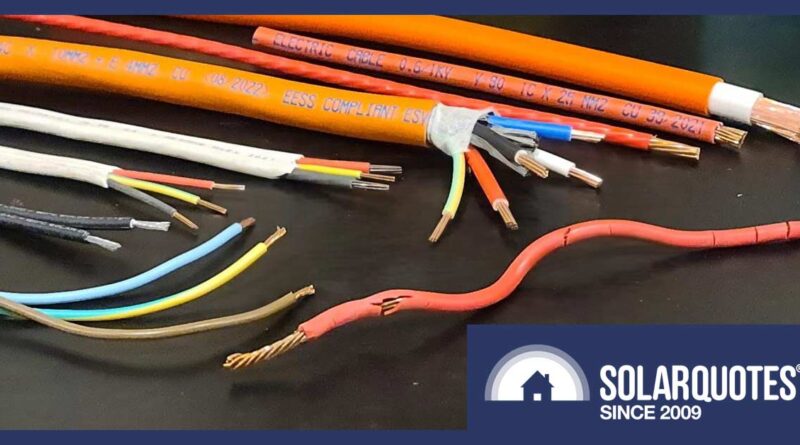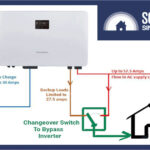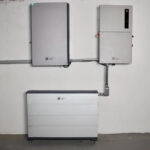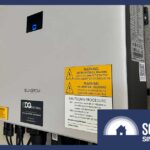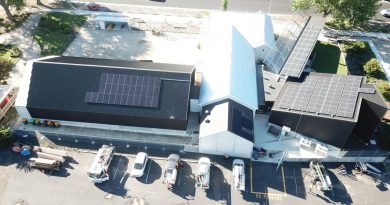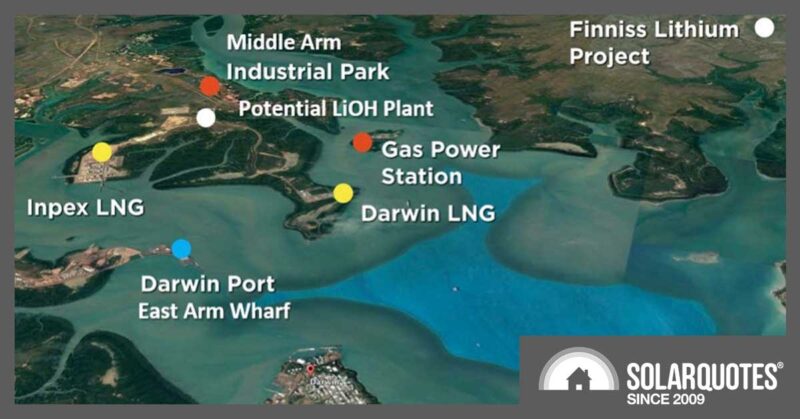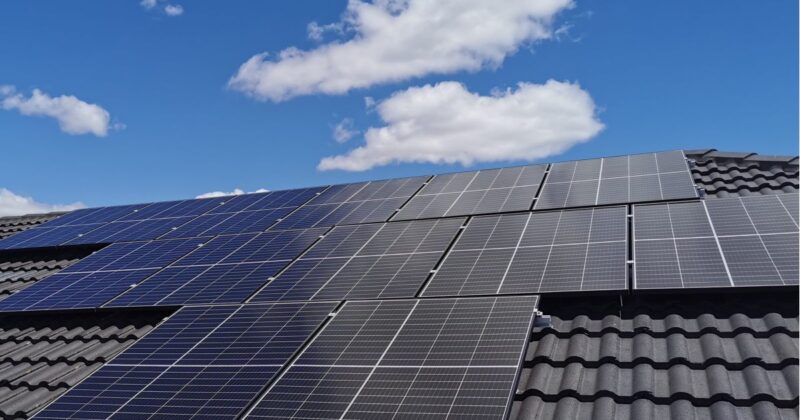The Problem Of Solar Voltage Rise/Drop And How To Fix It
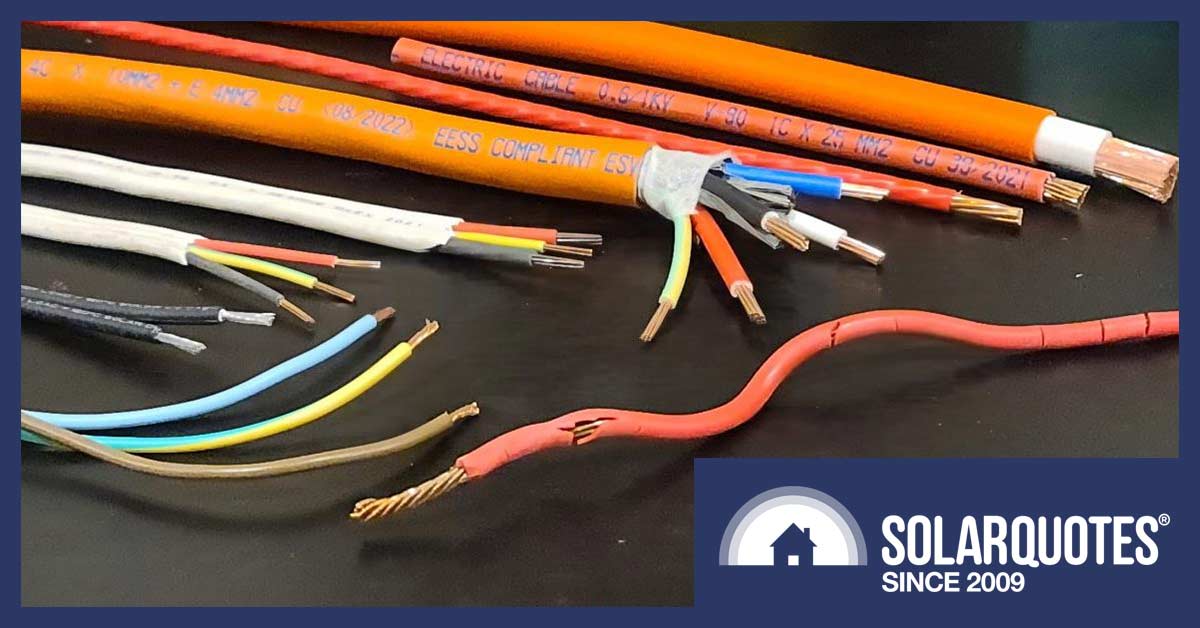
Top to bottom, 70mm² 25mm² 16mm² 10mm² (3 phase) 6mm² sheathed, 2.5mm² sheathed, 4mm² Solar DC, 3 x 2.5mm² flexible plus a dangerously cracked and brittle 16mm² main service from a 1960s house.
Some weeks ago, I explained why the voltage in a long cable will drop over its length, and how this affects solar installations that are a long way from the switchboard.
Note: I call this a voltage drop, other people call the exact same phenomenon a voltage rise. It just depends on your perspective. Just like when I go to the bar: I experience a dollar-drop, the bar-owner experiences a dollar-rise but it’s the same transaction.
In this post, I’ll explore the finer details of voltage drop. I’ll provide details you can use to sort the wheat from the chaff (or the plumbers from the electricians). I’ll keep it as simple as I can, and then at the end, share some advanced insights for the true geeks.
Plumbers Can Help Us Understand Voltage Drop
There are only two things you need to know to be a plumber:
- Shit flows downhill.
- Payday is Thursday.
You need to know a few more things to be an electrician:
- Given half a chance, electricity will kill you.
- There will always be losses in a cable. Losses = voltage drop.
- If you need a stepladder, borrow the plumber’s wallet and stand on that.
The funny thing is that as an electrician, you often have to borrow the plumbers’ vernacular.
- Voltage (Volts) in a cable = pressure in a pipe.
- When the water flows down a pipe, there is a pressure drop (AKA losses) from one end to the other. When electricity flows through a cable, there is always a voltage drop from one end to the other.
When dealing with grid electricity1, the ‘pressure in the pipes’ is 230 V. Australian Standard AS 60038 dictates it should not drop below 216 V or exceed 253 V.
With such a limited range of pressure available, the adjustments available to the humble electrician to manage the voltage drop are:
- The cross-section of the pipes used. AKA cable thickness (mm2). The fatter the pipes, the smaller the losses.
- The length of the pipes. The shorter the pipe, the smaller the losses.
- The flow rate in the pipes; aka electrical current (Amps). The slower the flow, the smaller the losses.
5% Voltage Drop Allowed For Non-Solar Electrics
Electrical rules (AS3000) say that for any home (whether you have solar panels or not):
- From: the “point of supply” on your premises (which might be the fuse on the eave or the retail meter box)
- To: the farthest power point or light
…no more than 5% loss2 at full load is allowed3.
Only 2% Allowed For Solar
For solar power systems, the rules are more stringent. Australian Standard AS4777.1 stipulates a maximum 2% voltage drop from the solar inverter to the ‘point-of-supply’ (where your house connects to the grid).
Whether your installation abides by these two rules will depend on:
- The length of the cables
- The thickness of the cables
- The maximum current through the cables
- And how much loss has already been built into your existing supply cabling.
A good solar installer will visit your home before any firm quote to measure the distances involved and existing cable thicknesses. These numbers will go into a ‘voltage drop’ formula. Depending on the results, you may need to have a deep and meaningful conversation, or even a spirited debate with your favourite electrician.
Meeting the letter of the 2% law can be pretty difficult. Some electricians will be incredulous that you are asking questions about it.
Three-Phase Solves A Lot Of Voltage-Drop Problems
What can make all the difference is whether you have a single or a three-phase supply. For the examples I’ve rambled through below using a 6.6kW system, a single-phase supply must handle 28 amps. Spread across three phases, that same energy drops to 9.3 amps, which you can push three times as far for the same-sized cable.
What Size Cables Will I Need?
Let’s assume Dad’s got a workshop in the shed 67 meters away from the house. Assume that in reality there’s already a 1% loss in the service cable (i.e. from the switchboard to the point-of-supply).
Non-solar installations can operate at a 5% total loss, so the cable from the workshop to the house can operate at 4% loss. Congnisant with the rules, the workshop was originally wired up with a 6mm2, 67 m long cable and a 32 A breaker in the house.
Now we want to put solar panels on the workshop.
For a 32 A circuit, you can run a little over 7 kW of solar, connected via 10 metres of 6 mm2 cable with 1% loss. That’s not going to reach.
So, what if you want to put a 6.6 kW solar system on the shed? How do we cope with 67 metres of loss? I would approach it like this: 6.6 kW of input via an inverter with 97% efficiency means a peak demand of 28 A at 230 V AC.
Assuming the cable is multicore circular conductors of stranded copper operating at 75ºC, we need no less than 35 mm2 cross-section. It’s a lot of copper, which is expensive and difficult to handle when you’re trying to wrangle it through conduits and terminate it in the switchboard.
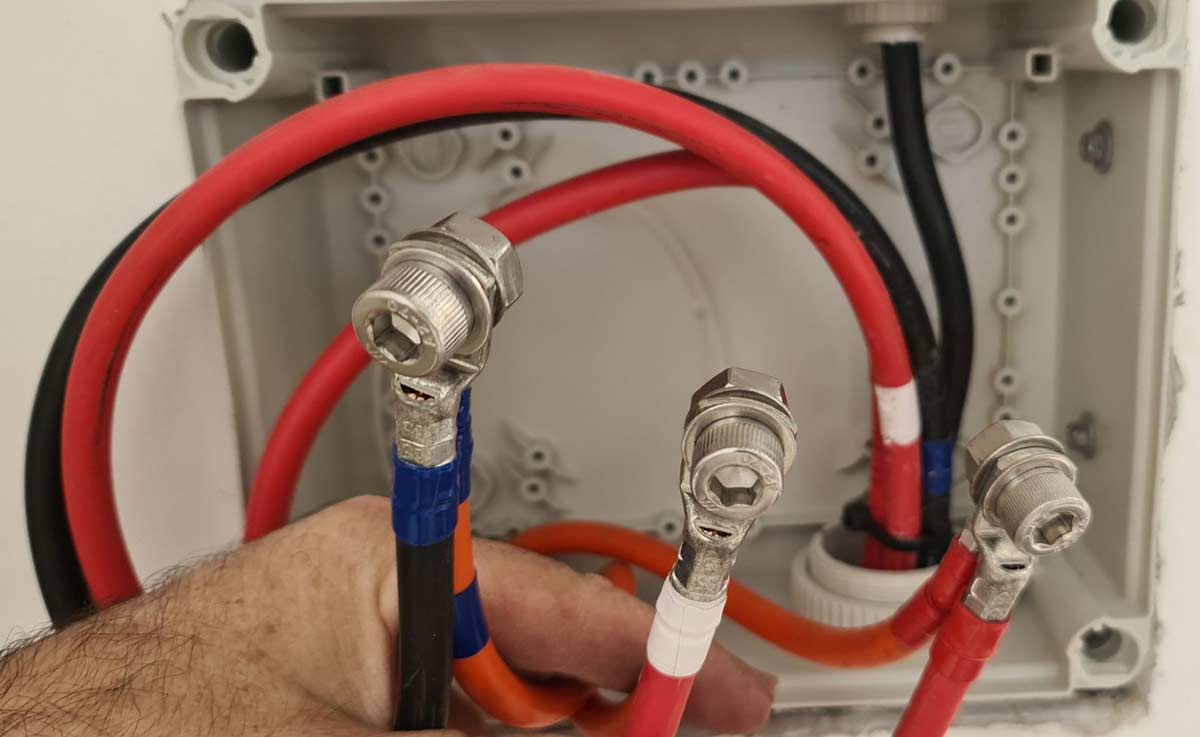
This is what 35mm2 cable looks like (the red and black cables). It’s difficult to work with and stiff like a green tree branch. After a long-distance run, breaking it down to a more manageable size (the orange cables) near its destination is common practice.
Is There An Alternative That Still Uses The Legacy 6mm2 Cable?
If we tweak the sums, assuming a grid voltage of 250V AC, upsize wiring to improve the service cable loss from 1 to 0.4% and use an export limiting device to throttle the solar system at 2kW output, then you’ll squeeze 8 A over 67 m at 1.6% loss.
This may seem like a waste of potential. It certainly isn’t perfect by any means, but many solar systems will spend a lot of hours below 2 kW output. If you can move some loads to the shed, such as a clothes dryer, deep freezer, beer fridge or better still, a home battery or even an electric car, then the system can run these loads without much inefficiency and still push 2 kW back to the house or grid.
An Even Better Alternative: DC Cables
Covering the distance with high-voltage DC is possibly the best answer if you have the right solar design. It will still involve a trench or overhead conduit to carry new cables, and care must be taken to ensure the earthing between the buildings remains compliant and doesn’t generate faults.
High voltage and low current will do the same work as low voltage and high current. The AC side of your system is limited to 250ish volts, but the DC side is legal up to 600 volts. Sadly, conflicting Australian standards prevent us from using 1000 volts, which everything is designed for internationally4.
For a DC circuit, we would normally run a pair of 6mm2 cables for two inverter input channels. So with a spec sheet I have on hand for current generation 415 W solar panels, you could squeeze under the crazy Australian standard 600VDC ceiling, if you have 15 in series for a maximum voltage of 561VDC (depending on temperature correction).
At peak efficiency, these modules are punching out 466 volts at 13.35amps (or 6.22kW) working at 1.4% loss, with an added bonus: no voltage rise problems you could otherwise encounter with the AC grid.
And seeing as you have two inverter inputs, you can have a 12.44 kW system, which would call for cable as fat as your thumb if you tried to manage it with AC wiring.
What If There Are Already Voltage Problems On The Street?
With 30% of Australian premises now having solar connections, there are whole streets in suburbs and states that have little power stations on every roof. The market and power system designed 100 years ago has been completely upended. Where once a hub and spoke network had predictable loads and fairly consistent losses cascading through from generator to consumer, the rise of the prosumer with their own choice means we have democratised energy.
The networks find it difficult though, because thousands of tiny generators behind the meter, pushing the network in reverse at the whim of the sunshine, is harder to manage than a 24-hour cycle with one morning and evening peak. They can use transformers with automatic tap changers to adjust the system voltage according to load. More of those are required now, and they’re working much harder every day.
The other tool networks use is export limiting. They simply put a lid on the power and therefore, the current flowing back from the customers. For many years this has just been a 5 kW ceiling on export at any given time. Hence 5 kW inverters with 6.6 kWp of modules became a thing. In more problematic areas, solar is throttled more, with large and small systems limited to 4 kW or 2 kW or even zero export limits.
So, if you and all your neighbours have solar panels and the grid voltage is very high on a sunny day, you’re entitled to complain to the DNSP (Distributed Network Service Provider). There are national rules they have to comply with, but they’re not always able or very interested in helping, especially if you’re out in the country on a skinny SWER connection with your own little transformer.
Some DNSPs are slow to respond, some view solar power as the problem and impose export limits; making the problem go away without investing in more infrastructure. I am all for making the network deal with the problems. Still, from experience, they aren’t always willing or able to do much, despite many letters written to the Australian Energy Regulator, the minister or local member.
There Is Another Way
Quietly install one of these units and be done with it.
They are only good for 5 kW of voltage-controlled throughput, but I know of people who use them, and they’ve found that quite satisfactory.
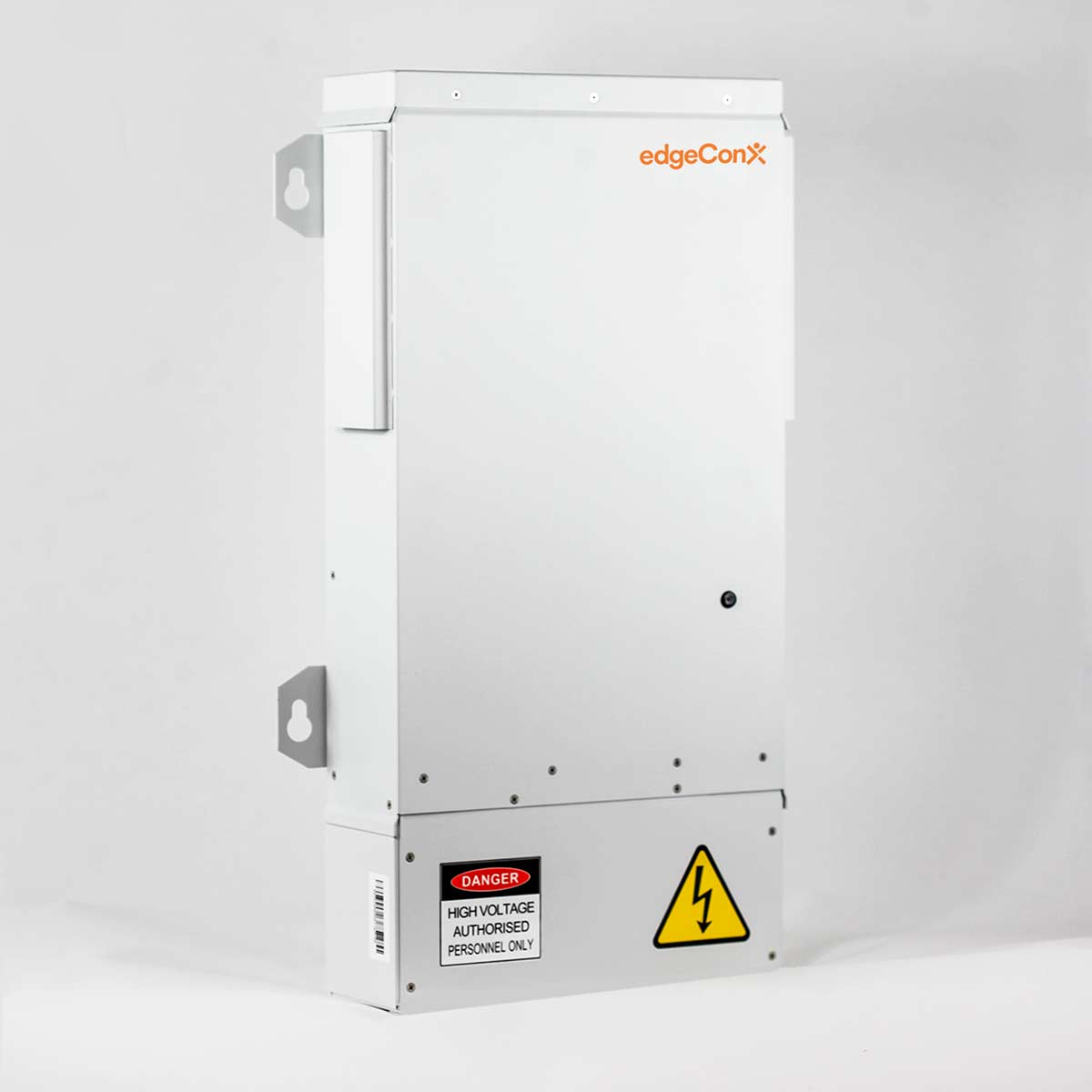
What the machine does is “condition” the incoming supply. You cable it in after the main switch, and the whole place will be fed with a steady 225 volts. Your solar power system will see the same voltage and function as intended, however the line side/network supply voltage will be driven up to whatever is required to make the energy flow back to the network.
There’s nothing illegal about it, and there are no specific prohibitions on this device. You are shifting the problem – possibly making it worse for the neighbours but better for the DNSP. The approach seems to be that if your DNSP no longer hears from you as a squeaky wheel, they aren’t bothered. A bonus is all your appliances will produce less waste heat, work more efficiently, and your bills will fall as a result.
You’ll be wholly unsurprised that the electricity industry doesn’t mind much if the grid voltage is high. It just means they can bill you for more energy.
While high voltage is not as easy to fix as a blocked drain, hopefully you now understand the causes and some solutions to an often ignored part of solar energy.
For Advanced Players Only
Example #1 Measuring loss on an existing system
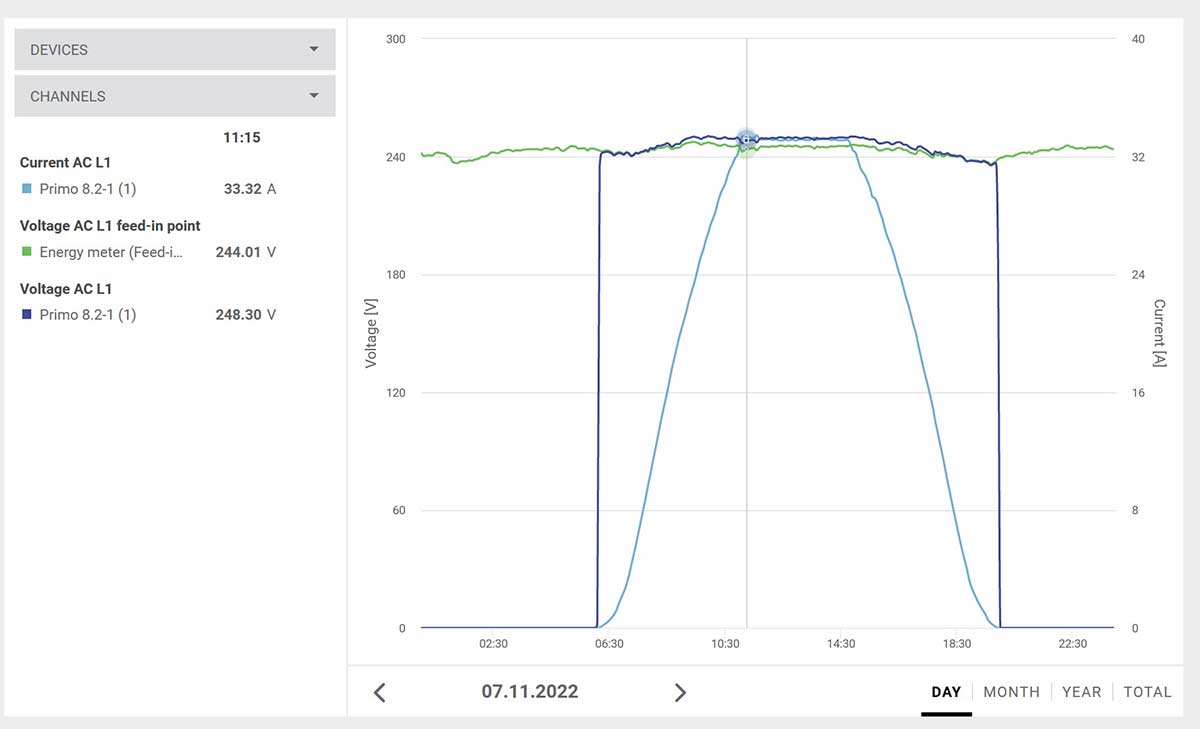
A Fronius Primo 8.2 with its tongue hanging out pushing 33 A. The consumption meter adjacent to the service fuse shows the grid voltage is 244 V. There’s a length of 6 mm2 cable between the inverter and sub-board, then 16 mm2 cable to the main switchboard. 248.3 V – 244 V = 4.3 V being lost along this route, so it just scrapes in at around 1.7% loss.
Example #2 Inverter Shutdown Due To High Voltage On A SWER Line
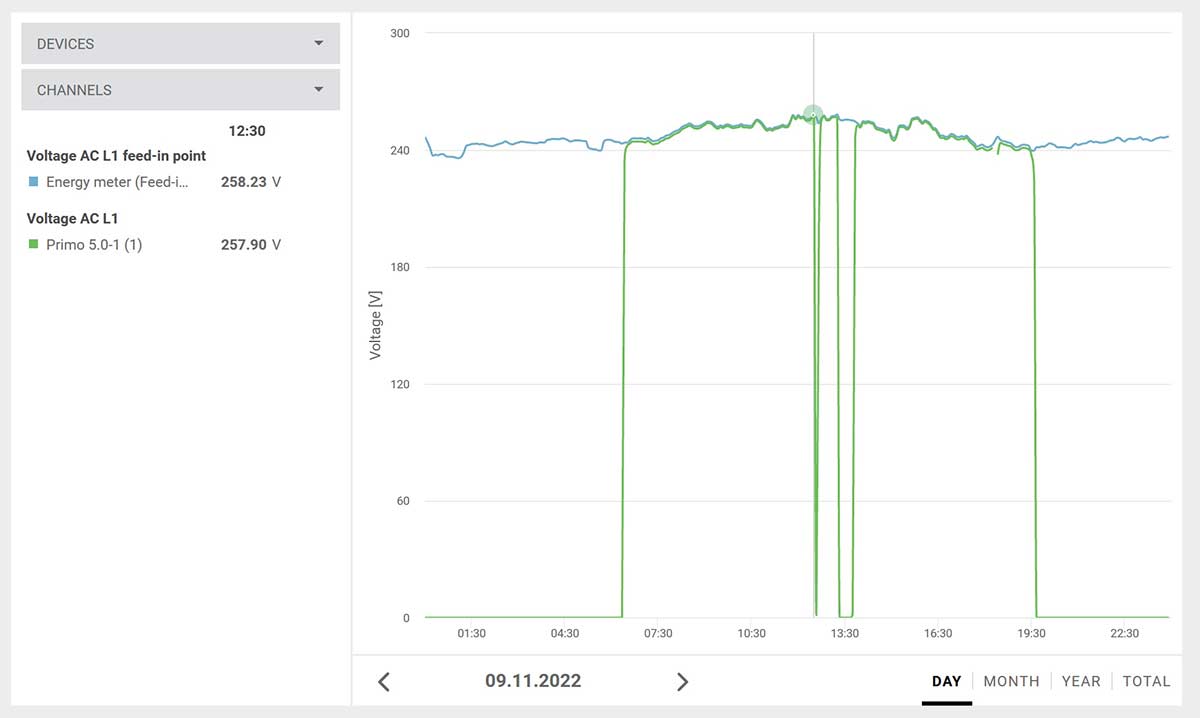
A hard-working SWER transformer. The green line shows the modest export limited system is generating 257.9 V and is about to cut out because other solar systems are driving the grid voltage to 258 volts plus.
Footnotes
- Specifically, the consumer part of the distribution network ↩
- resistive. ↩
- Of course, there’s an app for that. ↩
- It’s a little ironic that the “war of the currents” – were it played out with today’s power handling electronics – might not have been won by GE and Westinghouse, especially as we are now seeing a need for massive DC sources to fast-charge cars. It seems everything that is 120 years old is new again. ↩
Original Source: https://www.solarquotes.com.au/blog/solar-voltage-rise-drop/

